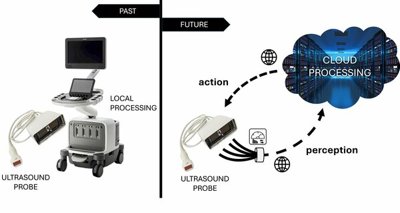ERC Proof of Concept grant for research into cloud-native ultrasound imaging
Ruud van Sloun receives €150.000 from European Union to introduce a fully cloud-native ultrasound imaging solution.
Artificial intelligence (AI) is already being used in many ways to improve quality of medical imaging (e.g., MRI, X-ray and ultrasound). In particular, improving the image quality of ultrasound can make affordable and reliable medical imaging accessible around the world, thanks to the (relatively) low cost of an ultrasound machine compared to, say, an MRI system. According to TU/e researcher Ruud van Sloun the missing puzzle to get more out of ultrasound imaging is to take inspiration from the brain and close the ultrasound perception-action loop: “Intelligent agents, like the brain, seek information in a goal-directed manner, where new actions lead to perceptions and perceptions lead to new, optimized actions. Current imaging systems do not have a closed perception-action loop and always execute the same sequence of actions, regardless of past observations. That’s what I want to change. I believe we can make ultrasound smart so that it will actively start looking for the important information, just like humans do, with a closed perception-action loop.” The European Research Council (ERC) has granted Van Sloun a Proof of Concept subsidy worth €150.000 for his research on cloud-native ultrasound imaging based on this new approach.
Van Sloun’s ERC starting grant project, US-ACT, proposes a brain-inspired paradigm for ultrasound imaging. It recognizes that the cycle of ultrasound data acquisition and reconstruction can be interpreted as a perception-action loop: the action is the acquisition, probing the anatomy, and the perception is the reconstruction that infers what anatomy most likely generated that acquired data. Through this lens, he interprets the ultrasound imaging system as an agent, which strives to perform actions and perceptions that minimize uncertainty about the anatomical world, and thus maximize important diagnostic information. To be effective at achieving this, the agent must understand the environment, and the consequences of actions on that environment. In US-ACT, this is achieved by equipping the agent with deep generative AI models that govern these beliefs.
Together with PostDoc Ben Luijten and Doctoral Candidate Beatrice Federici, van Sloun is now working on a paradigm shift in imaging that is enabled by the US-ACT proposition: fully cloud-native ultrasound. Beatrice Federici explored the foundations for this new approach in her thesis “Real-time Cloud-based Ultrasound System for Advanced Image Formation and Image Settings Autotuning”, which recently won the TU/e Science Award for the best EngD thesis of 2023 (EngD course Design of Electrical Engineering Systems). Watch the pitch: https://lnkd.in/eTGSsTdz EngD Thesis: https://lnkd.in/evm_UBg4.
Unlimited computing power, memory and storage
“In this ERC proof-of-concept project, we intend to democratize access to this new high-quality ultrasound imaging paradigm developed in US-ACT, by introducing a fully cloud-native ultrasound imaging solution, unlocking access to virtually unlimited computational power, memory, and storage for raw ultrasound sensor data. This will enable unprecedented image quality and diagnostic insights at scale, all without sacrificing latency and frame rates. It will break the compromise between quality and cost in ultrasound. We will move all the computational complexity away from the local device to a cloud server, offering full scalability and no longer requiring the expensive and bulky cart that currently hosts all this compute and storage. 
Interested? Read more about this research and the researcher on the website of TU Eindhoven.